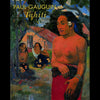Paul Gauguin Tahiti
Pressedownload
Der Pressedownload darf nur im Zusammenhang mit einer Buchbesprechung verwendet werden. Für die Illustration einer Buchbesprechung können nur bis zu drei Bilder genutzt werden. Für andere Textformate und Nutzungszwecke (wissenschaftliche Vorträge, Werbung oder ähnliches) bitten wir Sie, vorab mit uns in Kontakt zu treten, um mögliche Fragen zu Honorarkosten, Nutzungsund Urheberrechten zu klären. Die bereitgestellten Bilddaten dürfen nicht manipuliert, beschnitten oder zweckentfremdet verwendet werden. Die Pressebilder dürfen nur mit dem vollständigen Bildtitel, dem Namen des Künstlers und/oder Urhebers sowie mit dem Hinweis auf den Hatje Cantz Verlag veröffentlicht werden. Bitte beachten Sie außerdem im Einzelfall die Reproduktionsbedingungen der VG Bild-Kunst Bonn bzw. der internationalen Verwertungsgesellschaften für Bildende Kunst.
Paul Gauguin
In 1892 Paul Gauguin travelled to the South Seas. The extraordinary paintings and sculptures, watercolours, drawings and coloured woodcuts from this first journey make it abundantly evident why Gauguin, together with CÚzanne and van Gogh, counts as one of the Fathers of Modern Art.ì The Brittany landscapes and still lifes mark Gauguin's departure on his life's journey, seeking the roots of artistic expression. On Tahiti he found a world where exotic dreams and colonialism abruptly collided. His glowing images from the last decade of his life - with its impressive creativity and deep loneliness - capture the essence of a dying world.ì The reality of life on Tahiti and its archaic culture became an important part of Gauguin's own life, in which utopia and reality were ultimately never to be reconciled. This study of Gauguin's richly symbolic pictures reveals an epoch-making moment in his art. (English edition out of print) The artist: Paul Gauguin (Paris 1848 - 1903 Atouana on Hiva-Oa, in the Marquesas Islands). Spent 1865-1871 at sea. 1871-1882: bank employee in Paris. 1874: attended the Colarossi Academy. 1876: debut in the Paris Salon with Sous-bois Ó ?Viroflay.? 1886: first journey to Brittany (Pont-Aven). 1897: publishes his book Noa-Noa about his time in the South Seas from 1891-1893. In 1895 Gauguin leaves Europe for the last time.



